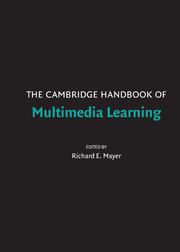Book contents
- Frontmatter
- Contents
- Preface
- Contributors
- 1 Introduction to Multimedia Learning
- PART I THEORETICAL FOUNDATIONS
- 2 Implications of Cognitive Load Theory for Multimedia Learning
- 3 Cognitive Theory of Multimedia Learning
- 4 An Integrated Model of Text and Picture Comprehension
- 5 The Four-Component Instructional Design Model : Multimedia Principles in Environments for Complex Learning
- PART II BASIC PRINCIPLES OF MULTIMEDIA LEARNING
- PART III ADVANCED PRINCIPLES OF MULTIMEDIA LEARNING
- PART IV MULTIMEDIA LEARNING IN CONTENT AREAS
- PART V MULTIMEDIA LEARNING IN ADVANCED COMPUTER-BASED CONTEXTS
- Author Index
- Subject Index
- References
3 - Cognitive Theory of Multimedia Learning
Published online by Cambridge University Press: 05 June 2012
- Frontmatter
- Contents
- Preface
- Contributors
- 1 Introduction to Multimedia Learning
- PART I THEORETICAL FOUNDATIONS
- 2 Implications of Cognitive Load Theory for Multimedia Learning
- 3 Cognitive Theory of Multimedia Learning
- 4 An Integrated Model of Text and Picture Comprehension
- 5 The Four-Component Instructional Design Model : Multimedia Principles in Environments for Complex Learning
- PART II BASIC PRINCIPLES OF MULTIMEDIA LEARNING
- PART III ADVANCED PRINCIPLES OF MULTIMEDIA LEARNING
- PART IV MULTIMEDIA LEARNING IN CONTENT AREAS
- PART V MULTIMEDIA LEARNING IN ADVANCED COMPUTER-BASED CONTEXTS
- Author Index
- Subject Index
- References
Summary
Abstract
A fundamental hypothesis underlying research on multimedia learning is that multimedia instructional messages that are designed in light of how the human mind works are more likely to lead to meaningful learning than those that are not. The cognitive theory of multimedia learning (CTML) is based on three cognitive science principles of learning: the human information processing system includes dual channels for visual/pictorial and auditory/verbal processing (i.e., dual-channels assumption); each channel has limited capacity for processing (i.e., limited capacity assumption); and active learning entails carrying out a coordinated set of cognitive processes during learning (i.e., active processing assumption). The cognitive theory of multimedia learning specifies five cognitive processes in multimedia learning: selecting relevant words from the presented text or narration, selecting relevant images from the presented illustrations, organizing the selected words into a coherent verbal representation, organizing selected images into a coherent pictorial representation, and integrating the pictorial and verbal representations and prior knowledge. Multimedia instructional messages should be designed to prime these processes.
The Case for Multimedia Learning
What is the rationale for a theory of multimedia learning? People learn more deeply from words and pictures than from words alone. This assertion – which can be called the multimedia principle – underlies much of the interest in multimedia learning. For thousands of years, words have been the major format for instruction – including spoken words, and within the last few hundred years, printed words.
- Type
- Chapter
- Information
- The Cambridge Handbook of Multimedia Learning , pp. 31 - 48Publisher: Cambridge University PressPrint publication year: 2005
References
- 804
- Cited by

